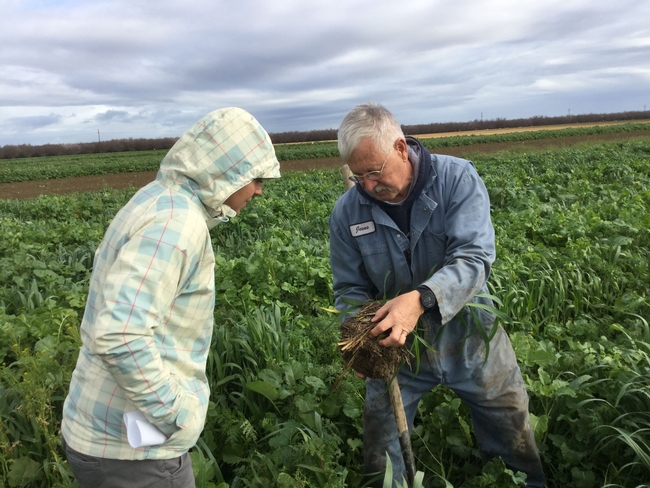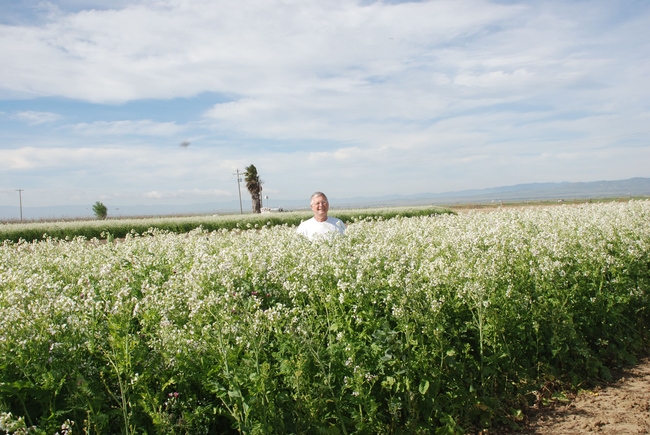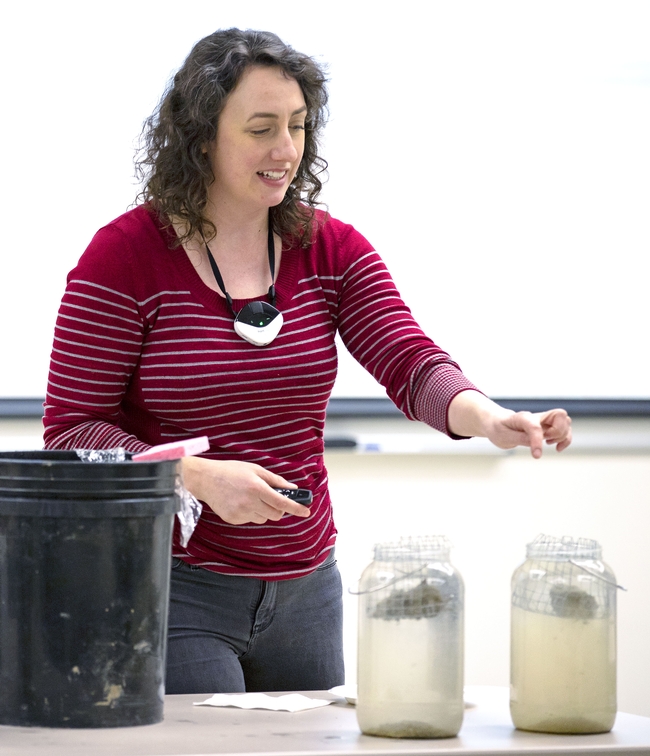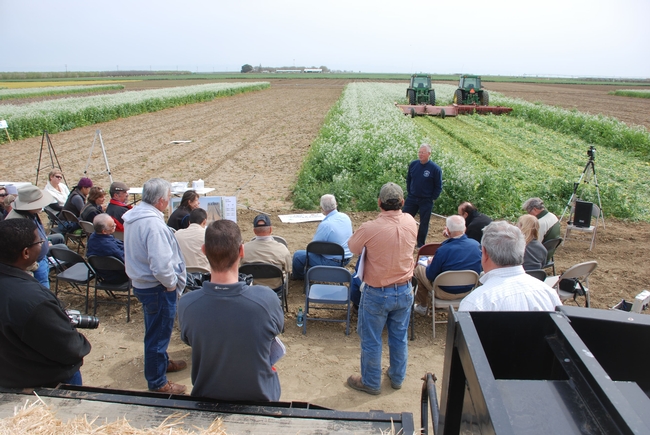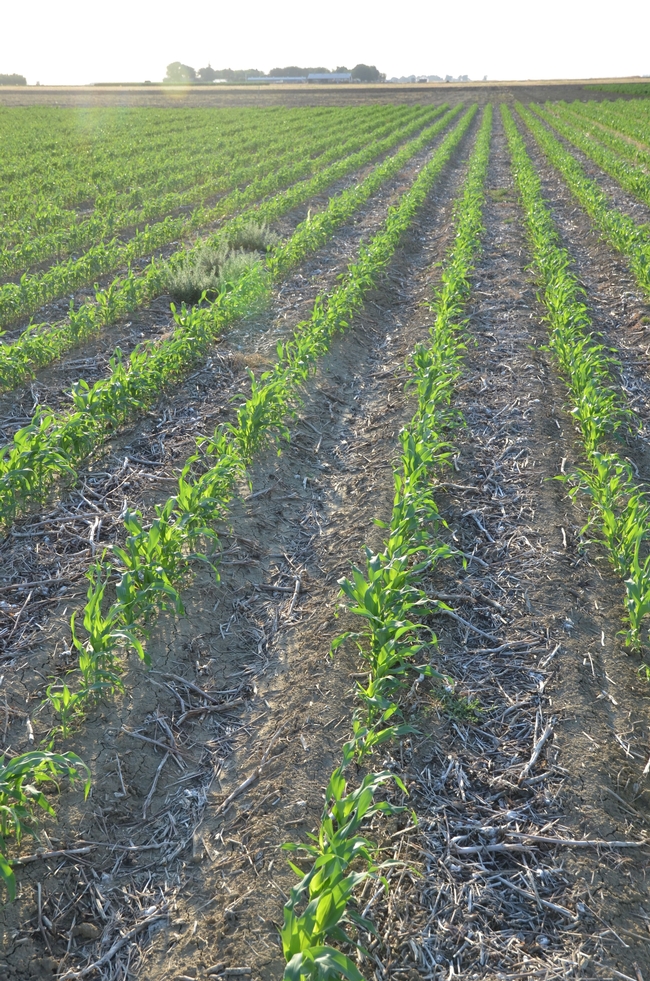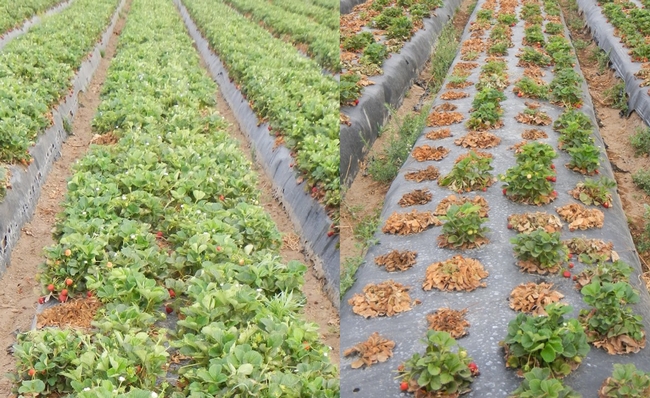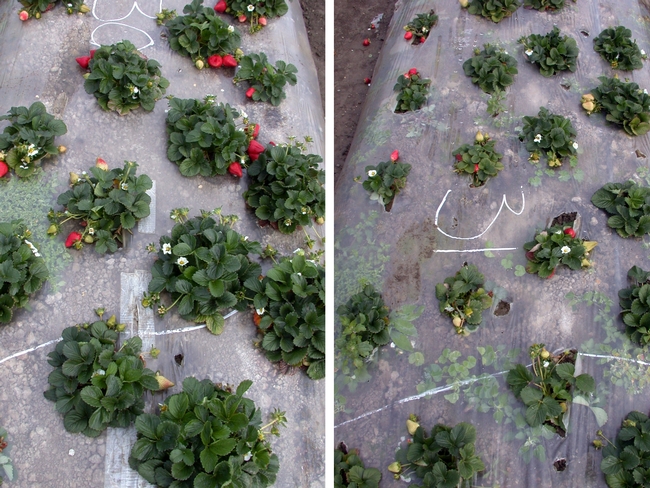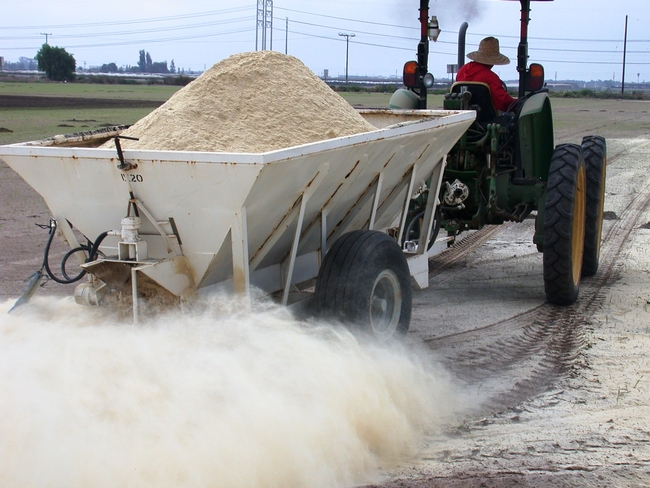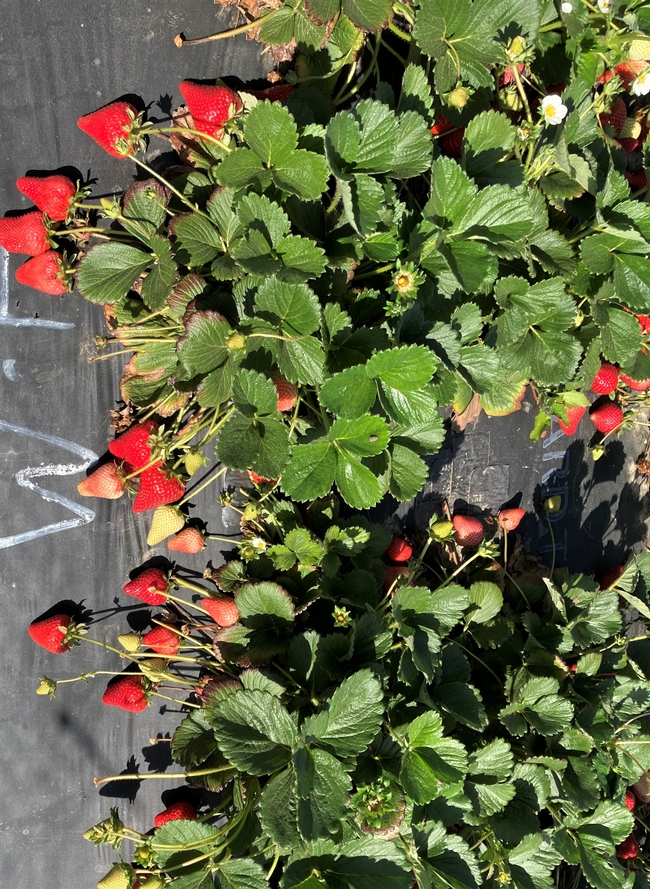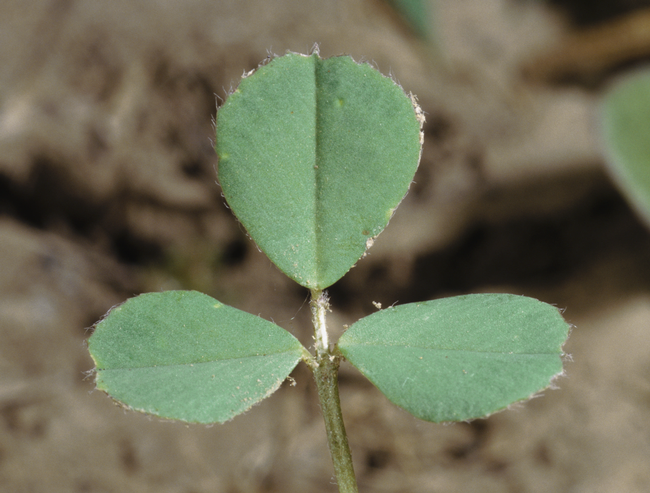
Posts Tagged: soil
Franco: Deciphering Soil Macrobiome and Ecosystem Responses to Global Change
It promises to be an outstanding seminar. André Custodio Franco, assistant professor, Indiana University, Bloomington, will speak on "Deciphering the Soil Macrobiome: Belowground Communities Driving Ecosystem Responses to Global Change" at a seminar hosted Monday, Nov. 18 by the UC...

What's up with soil and global change? Andre Franco of Indiana University will speak on "Deciphering the Soil Macrobiome: Belowground Communities Driving Ecosystem Responses to Global Change" at 4:10 p.m., Monday, Nov. 18 in 122 Briggs Hall. It also will be on Zoom and then archived. (Photo by Kathy Keatley Garvey)
Zeroing in on Soil Invertebrate Communities
You might call it earth-shattering, but better, "an eye-opener about soil compositions." Associate professor Kyle Wickings of the Department of Entomology and Nematology, New York State Agricultural Experiment Station, Cornell University, will speak on “Composition and Function of Soil...
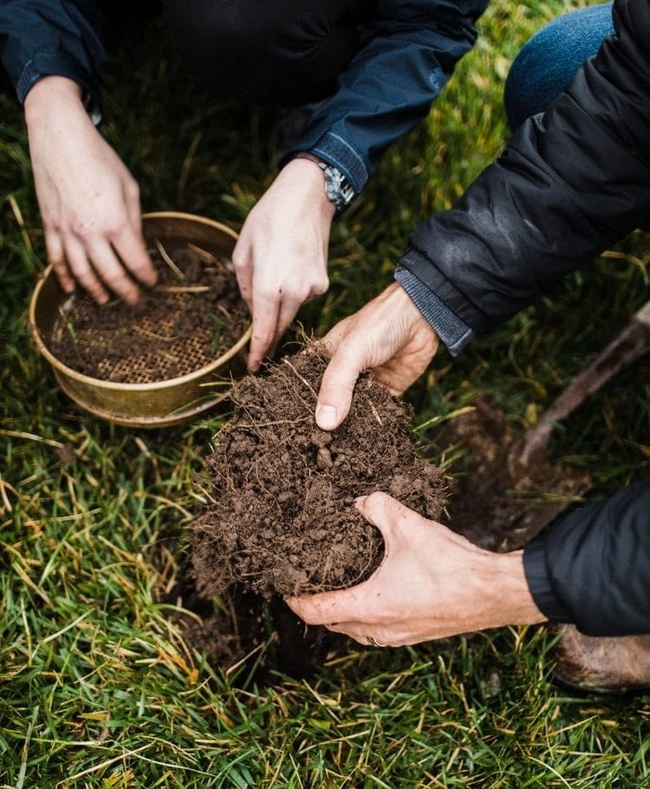
This is an image from Kyle Wickings' soil arthropod ecology lab at Cornell University.
West Side REC study: A cradle of California regenerative agriculture
In 20-year study, UCCE specialist Mitchell, colleagues, growers advance no-till and cover cropping practices
In the 1990s, long before “regenerative agriculture” was a buzzword and “soil health” became a cause célèbre, a young graduate student named Jeff Mitchell first learned about similar concepts during an agronomy meeting in the Deep South.
Mitchell was astonished to hear a long list of benefits attributed to practices known internationally as “conservation agriculture” – eliminating or reducing tillage, cover cropping and preserving surface residues (the plant debris left after harvest). Potential positive impacts include decreasing dust in the air, saving farmers money on fuel and equipment maintenance, improving soil vitality and water dynamics and a host of other ecosystem services.
“All of these things start adding up and you kind of scratch your head and say, ‘Well, maybe we ought to try some of this,'” recalled Mitchell, who became a University of California Cooperative Extension cropping systems specialist at UC Davis in 1994.
In 1998, Mitchell launched a long-term study of those practices at the West Side Research and Extension Center (REC) in Five Points, Fresno County. “We started this because, way back when I first began my job, nobody was doing this,” he explained. “This was brand-new, uncharted territory for California.”
For the next 20 years, Mitchell and his colleagues studied changes to the soil and ecosystem, learned from their failures and successes, and shared those hard-won lessons with fellow scientists and farmers across the state. A summary of their findings was recently published in the journal California Agriculture.
Conservation agriculture in California: ‘No trivial undertaking'
Mitchell and the Conservation Agriculture Systems Innovation Workgroup – a network established in 1998 comprising farmers, researchers, public agency personnel and members of private entities and environmental groups – started with a virtually blank slate. According to Mitchell, surveys at the beginning of the 21st century found that conservation agriculture practices were used on less than one-half of 1% of annual crop acreage in California.
Although no-till is common in the Midwest and Southeast of the U.S. and across wide swaths of the globe, it was almost unheard of in the Golden State. With the development of irrigation infrastructure in the 1920s, California farmers saw continually phenomenal growth in yield over the last century – and thus had little incentive to deviate from tried-and-true methods that relied on regular tillage.
Nevertheless, intrigued by the potential benefits of conservation agriculture, Mitchell wanted to see which of those practices could be feasibly applied to California cropping systems. During the 20-year study at West Side REC, the researchers grew a rotation of cotton-tomato, followed by a rotation of garbanzo, melons, and sorghum, and finally tomatoes.
But at first, it was a struggle to grow anything at all – as they had to master the basics of how to establish the plants in a no-till, high-residue system.
“This was no trivial undertaking,” Mitchell said. “Early on we struggled – we failed the first couple of years because we didn't know the planting techniques and we had to learn those. There was an upfront, very steep learning curve that we had to manage and overcome.”
Then there was the long wait to see any measurable improvements to soil health indicators, such as the amount carbon in the soil.
“For the first eight years, we didn't see any changes whatsoever,” Mitchell said. “But then they became strikingly different, between the no-till cover crop system and the conventional field without cover crops, and the divergence between those two systems became even starker.”
The two-decade time horizon for the West Side REC study is one major reason why it has been so valuable for growers and scientists alike.
“It's so hard to capture measurable changes in soil health and soil function metrics through research because those changes are really slow,” said Sarah Light, UCCE agronomy farm advisor for Sutter, Yuba and Colusa counties and a co-author of the recent California Agriculture paper. “Often in the course of a three-year grant you don't actually get statistically significant differences.”
Reaching, teaching and learning from farmers
The study site on the west side of the San Joaquin Valley also has been a vital teaching resource. Even though Light works with farmers in the Sacramento Valley, she has conveyed findings from that research with her clientele and uses soil samples from the site to vividly illustrate a significant benefit of conservation agriculture practices.
In one demonstration, she drops soil aggregates – which look like clumps of soil – into two containers of water. One clump, from heavily tilled land, falls apart quickly and the water becomes dark and murky. The other, comprised of soil that has been no-till and cover cropped for 20 years, holds together – a sign of healthy, resilient soil – and the water remains relatively clear.
“It's a really simple demo, but it's very effective because it shows how easily soil aggregates break apart with water – or not,” Light said.
That aggregate stability is a key factor in soil's ability to both move water (infiltration) and hold onto water (retention). Those dynamics are crucial for farmers to avoid ponding in their fields, preserve water for drier months, and generally endure the flood/drought whiplash of climate change.
Over the years, Mitchell has hosted thousands of visitors at the West Side REC study site to showcase the potential benefits of adopting soil-health management practices.
“I don't think I'm exaggerating in saying that this is probably the most-visited agricultural field station project in the history of UC ANR (UC Agriculture and Natural Resources),” he said.
Both the West Side REC – and Mitchell himself – are greatly valued by the local grower community.
“Jeff is a microcosm of the university's applied research on the West Side of the San Joaquin Valley,” said John Diener, who grows almonds, fresh market garlic, canning tomatoes, cotton, masa corn and wheat for production and seed on land adjacent to the field station.
Growers adopt, adapt and adjust practices
Tom Willey, a retired farmer and longtime collaborator with Mitchell, has actively encouraged peers to visit the Five Points site – especially in the early years.
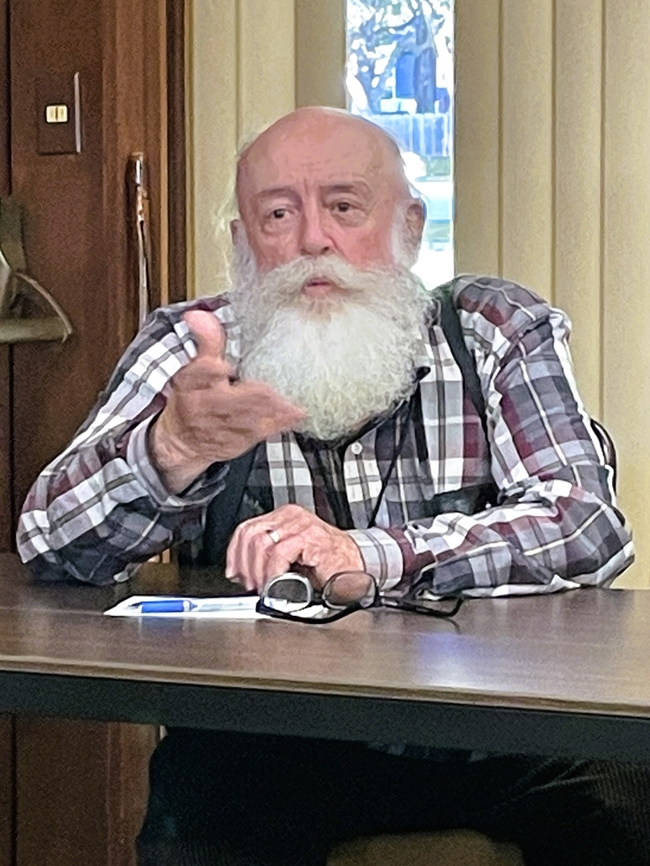
“It was very innovative and there weren't many examples of that anywhere in the state,” Willey said. “So, I helped encourage people to go out there and learn and possibly think about doing similar work on their own farms.”
Willey himself was a pioneer in experimenting with no-till practices in organic vegetable cropping systems.
“As organic farmers, we were probably more tillage dependent than conventional farmers because it was the only method we had for weed control; we weren't able to use herbicides,” Willey said.
Despite early struggles, he persisted in trying different techniques and mechanical means of weeding. And Willey later partnered with a group of progressive vegetable growers and UC and California State University Chico personnel to secure a Conservation Innovation Grant from the Natural Resources Conservation Service to support more on-farm trials and share their experiences.
In the end, however, no-till proved too risky to continue, given the losses they incurred. One tricky issue is nutrient cycling. The organic growers found that after mowing down a cover crop and spreading compost, leaving those nutrients on the surface without incorporating into the soil through more vigorous tilling (or adding synthetic fertilizers, as conventional growers could do) results in lower yields. In the short term, farmers simply did not see yields that could sustain their operation.
“It's very difficult in vegetable systems, and particularly difficult in organic vegetable systems,” Willey said. “I would say a number of us have learned to diminish the over-reliance that we had on tillage, but not to completely eliminate it.”
Cover cropping is also a challenge for some farmers, with certain cover crops making a perfect haven for devastating pests such as lygus bugs and stink bugs, according to Diener.
“We do everything we can to eliminate the host crop from which they come, so why am I going to bring the enemies to my house?” he said. “It's about making enough money to be there next year. You're not going to be there next year with these pests. It's just not a practical management option, in light of our significant pest pressure and disease hosts for our crops of value.”
Instead of planting cover crops, Diener said he opts for mixing in grain crops that can similarly contribute to soil health – while generating revenue at the same time. According to Diener, a longtime collaborator with Mitchell, the best way to adopt conservation agriculture practices is to tailor them to specific localities and each grower's circumstances. And in his corner of the San Joaquin Valley, that means not following the template of the high-precipitation, no-till systems found in the Midwest.
“We've adapted Jeff's principles to our program; it won't look like Iowa to you, which is what everybody comes to expect to see. It ain't how it works, folks,” Diener said. “It's a different methodology. We do those things that fit our environment and that's why that West Side field station is important – because it's our environment.”
Promoting and enhancing soil health, one step at a time
More widespread adoption of soil-health management practices can be driven by a variety of factors. With the rise of drip irrigation in tomatoes, for example, more growers began using no-till or reduced till to minimize disruptions to the delicate driptape in their fields.
And, according to Mitchell, the dramatic increase in no-till practices in dairy silage production – from less than 1% to over 40% – was the result of entrepreneurial efforts by a small but extraordinarily dedicated group from the private sector that worked with farmers, one by one.
Because optimizing these practices requires close and intensive attention – and no small amount of courage and gumption – Mitchell and Light understand that growers might need to take an incremental approach. Even one fewer pass over the field, or cover cropping every other year, can provide some benefit for soil health, Light said.
“The value is that when you can prove the concept, then you can motivate every step of the way,” Light explained. “Jeff is showing the shining light of the goalposts, and that can motivate us to take every challenging step along the way.”
Shannon Cappellazzi, who helped with the data analysis on the recently published California Agriculture paper, agrees that there is value in taking a stepwise approach in building soil health.
Cappellazzi was the lead project scientist on the Soil Health Institute's North American Project to Evaluate Soil Health Measurements, which looked at 124 different long-term soil research sites across the continent – including the Five Points site.
After analyzing 2,000 samples from the various study sites, Cappellazzi said the evidence suggests that layering on each component of a conservation agriculture program – doing no-till, adding cover crops and then integrating livestock, for example – can have additive, cumulative benefits for soil health.
“I think having the data to show the long-term benefit makes people willing to do the short-term change, even if it's a little bit hard for a couple years,” Cappellazzi said.
The research at the West Side REC also produced another key takeaway.
“To me, what really stood out was that for most of the soil health indicators, cover crops had a huge impact. Both the cover crops that had no till – and the cover crops that had standard tillage – had considerably higher carbon and soil health indicator measurements than those without cover crops,” said Cappellazzi. She added that the data also indicated improvements in how the water moved into the soil, and how the soil held that water.
Vital research drives an enduring legacy
Water management and conservation, of course, will be paramount in California's increasingly volatile climate reality. Mitchell's Five Points research – and related studies across the San Joaquin Valley by UC Davis agroecologist Amélie Gaudin and others – contributed data that overturned a long-held belief about winter cover cropping.
“There's a lot of preconceived ideas about cover crop water use,” Mitchell said. “One of the things that we learned was that compared to bare soil water loss in the wintertime, cover crop water loss during that same growing period – from about November through March – tends to be almost a wash.”
That crucial finding provided researchers and soil health advocates with invaluable evidence to preserve the practice as an option for farmers.
“They've needed to go around and give a dog-and-pony show to a lot of Groundwater Sustainability Agencies (GSA) that had been on the brink of banning the growing of cover crops because the perception out there is that they use a lot of water,” said Willey, the retired vegetable grower. “But over the winter months, cover crops don't use a lot of water. In fact, they may not use any net water at all.”
The young researchers who studied cover-crop water use represent another important legacy of the Five Points study site. It has been an experiential training ground for many of the next generation of soil scientists, agronomists and ecologists.
“The number of students who have been trained by and through this study has been really phenomenal,” said Mitchell, noting that they have worked on topics ranging from air quality to soil carbon related to no-till and cover cropping.
Their contributions will be essential in continuing to refine and optimize these practices that are fundamental to conservation agriculture. On Diener's concerns about lygus bugs and stink bugs, for example, Cappellazzi – in her new role as director of research at GO Seed – is studying and breeding cover crops with an eye on characteristics that make for less hospitable habitats for certain pests.
Indeed, while the California Agriculture paper effectively wraps up the 20-year study at Five Points, its lessons will continue to resonate and inspire for years to come.
“This is a step in a long journey,” Light said. “It's a launchpad – this paper might be able to tie a bow on it in terms of the data collection, but in terms of the extension impact, this is really just the beginning.”
And for Willey, the omnipresent climate crisis compels the entire sector to pick up the pace along that journey.
“We've got a lot of pressure now to evolve agriculture very rapidly in response to climate change and I don't think we can sit around and twiddle our thumbs,” he said. “We know the directions we need to be heading – with more natural systems mimicry and less reliance on toxic inputs and synthetic fertilizers – and we need to figure out how to incentivize and support farmers in moving in those directions.”
Organic strawberry yields boosted by technique refined through UCCE research
Anaerobic soil disinfestation helps suppress weeds, disease without fumigants
Troubled by puny plants, low yields and persistent mite problems, third-generation Southern California strawberry grower Glen Hasegawa was ready to give up on his transition from conventional to organic 12 years ago.
“I've always liked a challenge – but it turned out to be more of a challenge than I thought it would be!” he said.
But then, with the help of scientists including Oleg Daugovish, UC Cooperative Extension strawberry and vegetable crop advisor in Ventura County, Hasegawa tried a technique called anaerobic soil disinfestation (ASD). When applied correctly, the multi-step ASD process creates a soil environment that suppresses pathogens and weeds and makes for healthier, more robust crop growth.
“Back in the day, it was really hard to get the plant growing vigorously in organic,” said Hasegawa, owner of Faria Farms in Oxnard. “So we started using the ASD and then you could definitely see that the plant had more vigor and you could grow a bigger, better plant using it.”
Seeing that he could produce yields “in the neighborhood” of those grown in conventional strawberry fields fumigated with synthetic fumigants, Hasegawa was able to expand his original 10 acres of organic strawberries to 50 acres.
“I guess you could say I'm kind of a convert,” he said, noting that he now applies ASD to all his acreage each year in late spring.
Joji Muramoto, UC Cooperative Extension specialist in organic production based at UC Santa Cruz, has been experimenting with ASD since it was first brought to the U.S. from the Netherlands and Japan in the early 2000s. Carol Shennan, a professor in the Department of Environmental Studies at UCSC, and Muramoto were among the first to try the technique in California. They found that ASD successfully controlled an outbreak of Verticillium wilt – caused by the pathogen Verticillium dahliae – at UCSC's small organic farm in 2002.
Since then, Shennan, Muramoto, Daugovish and their colleagues have seen encouraging results at 10 trial sites across the state.
“We demonstrated that ASD can provide comparable yields with fumigants, in side-by-side replicated trials,” Muramoto said.
ASD promotes host of beneficial changes to soil ecosystem
ASD comprises three basic steps: incorporating a carbon source that is easily digestible by microbes in the soil (traditionally, rice bran has been used), further encouraging fermentation by covering the soil with plastic to limit oxygen supply, and finally adding water through drip irrigation to initiate the “anaerobic” decomposition of the carbon source and maintain the three-week “cooking” process.
The resulting cascade of chemical, microbiological and physical changes to the soil creates an ecosystem that is both conducive to strawberry growth – and inhospitable to pathogens and weeds.
“It's not like a pesticide where you have a mode of action, and thus resulting in ‘A' and ‘B' for you,” Daugovish explained. “There's a sort of cocktail of events that happens in the soil; they all happen interconnectedly.”
Compared to similar fields that did not undergo the process, ASD-applied organic strawberry fields across California have seen yields increase by 60% to 70% – and even doubling in some cases, according to Daugovish.
The UCCE advisor also shared the story of a longtime grower in Ventura County, who came to him with fields in “miserable” condition; they were plagued by one of the world's worst weeds, yellow nutsedge, and infected with charcoal rot, a disease caused by the fungus Macrophomina phaseolina. But after applying rice bran and following the ASD recipe, the grower saw phenomenal results.
“The only complaint he said to me was, ‘Now I have too many berries – we have to have more pickers to pick the berries!'” Daugovish recalled.
Via researchers' meetings, online resources, on-farm demonstration trials and word of mouth from peers, use of ASD by California strawberry growers has grown significantly during the past two decades. Tracking the purchase of rice bran, Muramoto estimated that about 2,500 acres were treated by the ASD-related practices in 2023 – covering roughly half of the 5,200 total acres of organic strawberries in California.
Muramoto directly links the growth of California organic strawberry production – which now comprises about 13% of total strawberry acreage in the state – with the increasing adoption of ASD.
“If you remove the acreage with the applied rice bran over the last 10 years or so, organic strawberry acreage is just flat,” he said.
Within the last decade, acreage of organic strawberries with ASD-related practices increased by 1,640 acres, which is a boon for air quality, human health and long-term soil vitality. According to Muramoto's calculations, that increase in organic acreage translates to a reduction of about 465,000 pounds of fumigant active ingredients that would have been used in growing conventional strawberries.
“There are hundreds of reports of acute illnesses related to fumigation in the record, so it's very important to find alternatives to fumigants,” said Muramoto, citing California Department of Pesticide Regulation documents.
Research continues to make ASD more economical, effective
The popularity of ASD has come at a price, however, for organic strawberry growers.
“There's more organic out there, and I think most of the organic guys are using it, so there's more demand on the rice bran; the price has been steadily going up every year, like everything else,” said Hasegawa, adding that he has been trying to decrease the amount of carbon while maintaining ASD's efficacy.
On top of greater demand from other growers and from beef cattle and dairy producers (who use rice bran as feed), the price also has increased due to higher costs in transporting the material across the state from the Sacramento Valley. So Daugovish and his colleagues – including Peter Henry, a U.S. Department of Agriculture plant pathologist – have been searching for a cheaper alternative.
“We all want an inexpensive, locally available, reliable, easy to use and functional carbon source, which sounds like a big wish list,” Daugovish said.
Carbon sources such as bark, wood chips, or compost are ineffective, as the crucial ASD microorganisms are choosy about their food.
“Microbes are just like cows; you can't feed them straight wood; they get pretty angry,” Daugovish explained. “And if you feed them something with too much nitrogen, they can't digest it – they get the runs. Microbes are the same way – you have to have the right proportion of stuff so they feel comfortable doing what they're doing.”
In search of an ideal replacement, researchers tried and ruled out grass clippings, onion waste, glycerin and coffee grounds. Finally, they pivoted to a material with properties very similar to rice bran: wheat bran, in the form of wheat middlings (also called midds, a byproduct of flour milling) and dried distillers' grain (DDG, a byproduct of ethanol extraction).
After field experiments in Santa Paula, the UC and USDA researchers found that midds and DDG were just as effective at controlling soilborne pathogens and weeds as rice brain – but at 25% to 30% less cost. Their results were published last year in the journal Agronomy.
“Not surprisingly, the wheat bran has worked almost exactly the same as rice bran,” Daugovish said.
He and Muramoto are now conducting trials with wheat bran at commercial fields, and the initial results are promising. Daugovish said the grower at one site in Ventura County has seen a 90% reduction in Macrophomina phaseolina, the causal pathogen of charcoal rot, in the soil – and an 80% to 90% drop in yellow nutsedge germination. They are waiting for final yield numbers after the coming summer.
While ASD has been beneficial to organic productivity and soil health, both Daugovish and Muramoto acknowledged specific limitations in suppressing the “big three” strawberry diseases: Verticillium wilt, Fusarium wilt and charcoal rot. In coastal areas with cooler soil temperatures, for example, ASD can actually exacerbate the latter two diseases, as the fungal pathogens feed on the rice bran.
“We know it works at warmer temperatures, but, practically, it's hard to do in coastal California,” Muramoto said. “It would be nice if we can find a way to suppress Fusarium wilt at a lower temperature, but we don't have it right now.”
That's why researchers emphasize that ASD is not a “silver bullet.” It's just one tool in the organic toolbox, which includes careful crop rotation, disease-resistant strawberry varieties and better diagnostic tests that help growers pinpoint outbreaks and make the application of various methods more targeted and more efficient.
And scientists will continue to optimize ASD to make it more effective and economical for growers in the different strawberry regions of California – from the Central Coast to the Oxnard Plain.
“We know it can work really well; it's just finding the most sustainable way to do this in our region,” Daugovish said. “We've got to just have an open mind and keep trying.”
California Plant and Soil Conference set for Feb. 6-7 in Fresno
The 2024 California Plant and Soil Conference will be held Feb. 6-7 at the DoubleTree Hotel in Fresno. The conference is organized by the California Chapter of the American Society of Agronomy and UC Cooperative Extension.
This year's conference will cover the following topics:
- Are we ready? Adapting agronomy to an uncertain future
- Precision agriculture
- Nutrient management
- Micronutrients
- Animal-plant systems management
- Soil management
- California IPM toolbox
- Pesticide resistance
- Bees, pollinators
- Groundwater recharge
- On-farm water management
“The diverse topics covered at the annual California Plant and Soil Conference are determined by polling members each year about what information is most important for them to learn about regarding sustainable agricultural production in California,” said Nicholas Clark, conference organizer and UC Cooperative Extension farm advisor, who specializes in agronomy and nutrient management.
Growers, pest control advisers and crop consultants, allied ag industry professionals, academics, and government agency staff attend this accessible, science-based conference each year to stay up-to-date on major issues in California agriculture and their potential solutions. In addition to networking opportunities, the conference offers continuing education credits for growers and other ag professionals seeking to maintain various licenses.
“Another really cool thing about this conference is that the chapter has a strong career development component to it,” said Clark. “We support students through financial assistance to attend as poster presenters, and we give monetary awards to student poster contest winners judged by members of the CA ASA board and industry professionals. We also have a merit-based scholarship award given to students each year for their contributions to and potential in the agricultural industry and science fields. These awards are largely supported by private sponsors and member dues.”
The annual conference provides an opportunity for all attendees to increase their knowledge of current topics of agronomic importance in California. By attending the conference, certified crop advisers and pest control advisers can earn continuing education units that are important to their professional standing.
The agenda for the conference includes several new items this year:
- Two additional sessions with six speakers will be offered on the afternoon of Feb. 7 after the business lunch.
- A student-mentor breakfast meeting will be held the morning of Feb. 7 with round-table discussions to hear about mentors' experiences and career paths in agricultural science fields, providing a chance to network and broaden perspectives.
In addition to presentations, there will be an award ceremony to honor individuals who served the profession through their careers, a student poster competition, non-competitive professional posters, and the CA ASA business meeting. Sponsorship opportunities are available to support student participation. For more information, please see the conference website at https://na.eventscloud.com/website/58588/sponsors.
Registration is $375. Early bird registration is $325 and ends Jan. 12. Registration on site will be $425. Register through the conference website: https://na.eventscloud.com/plantandsoilconference.
The conference is planned and presented by a team of volunteer professional agronomists from research institutions, UC Cooperative Extension, public agencies and private companies. If you are interested in serving on the board or have questions about the conference, please contact a current board member (https://na.eventscloud.com/website/58588/leadership).
The California Chapter of the American Society of Agronomy was founded in April 1971 by a group of California agronomists who recognized the value in creating a forum to focus on California agriculture. The purpose of the annual meeting is to promote research, disseminate scientific information, foster high standards of educational and ethical conduct in the profession, and facilitate robust cooperation among organizations with similar missions.

